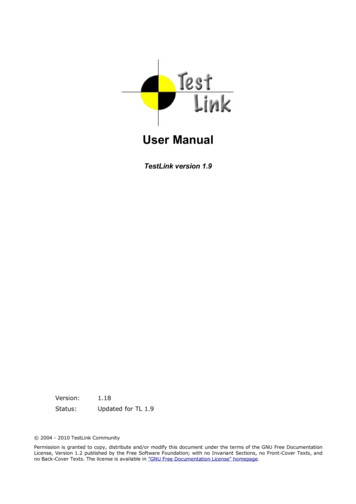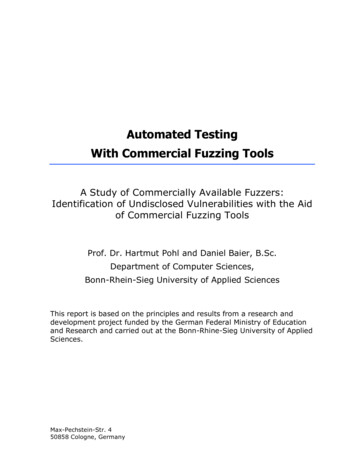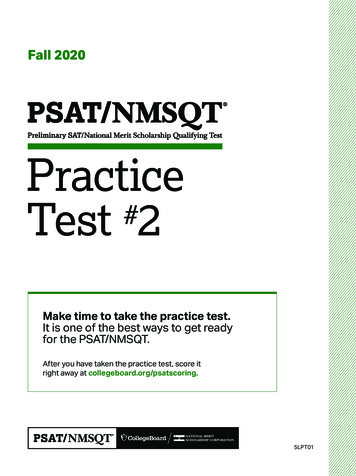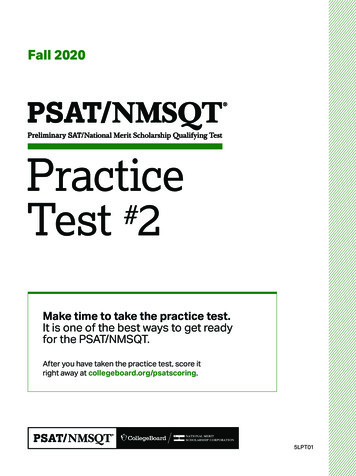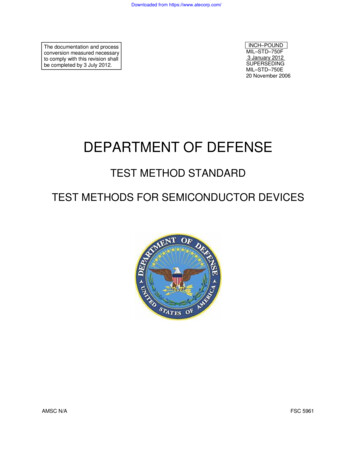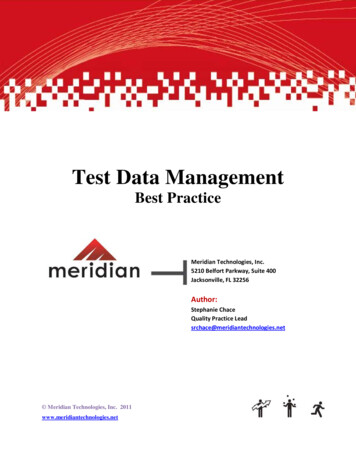
Transcription
Test Data ManagementBest PracticeMeridian Technologies, Inc.5210 Belfort Parkway, Suite 400Jacksonville, FL 32256Author:Stephanie ChaceQuality Practice Leadsrchace@meridiantechnologies.net Meridian Technologies, Inc. 2011www.meridiantechnologies.net
Table of Contents1.OVERVIEW . 12.THE IMPORTANCE OF GOOD TEST DATA . 13.START WITH REQUIREMENTS . 24.UNDERSTANDING YOUR DATA . 54.1DATA CLASSIFICATIONS . 54.2DATA SOURCES . 64.3DATA SELECTION CRITERIA . 75.BUILDING TEST DATA . 86.MANAGING THE PROCESS . 97.AUTOMATING THE PROCESS .108.SUMMARY .11
Test Data Management – Best Practice Overview1. OverviewA major component of many test efforts is the development and management of test data – to theextent that it is not unusual for test data creation and maintenance work to consume as much as 30to 50% of the total test effort. This effort typically represents a significant investment both in timeand money. Regardless of the amount, you want to get the most out of your test data investment.This paper will review why test data is important and help quantify what constitutes good test dataand test data management practices. We will elaborate on the best practices you can apply toensure you get the best possible test data for your investment. These best practices will be alignedto three basic test data management activities: Understanding your test data requirementsObtaining data to meet your test data requirementsMaking the test data process repeatable and scalableThese activities ensure we understand what we are trying to accomplish, enable us to actuallyaccomplish it, and then repeat our success. The general goals of maintaining high quality whilesimultaneously minimizing costs are critical. In addition, effective test data management supportsoverall improvements in test efficiency thereby helping to optimize your total test effort andprovide additional value to the business.2. The Importance of Good Test DataOur starting point is to understand why test data has become such a significant component of thetest effort. Generally speaking, test activities are designed to mimic real world usage of the systemwith the fundamental goal of detecting problems before they impact the intended users of thesystem. The more comprehensive and realistic the test effort, the more reliably testing can predict,and provide the opportunity to correct, erroneous behavior.In business applications, the impact of production failure can have devastating consequencesincluding loss of revenue and customer trust. In cases where software failures impact regulatorycompliance, companies may be subject to severe financial penalties or even litigation. In acomprehensive study completed by the US Department of Commerce, software defects wereestimated to cost US businesses nearly 60 billion dollars annually1, and the number is likelyrising with the increase in regulatory requirements.Since data plays a central role in today’s core business applications, we need to ensure that dataplays a similarly important role in our test efforts. Test teams need data with characteristics asclose as possible to real production data to properly test and evaluate system behavior. No data setis perfect, and many production failures are due to anomalies in the data which can only bedetected when these anomalies are present in the test data.Good or high quality test data will reflect the characteristics of your production data set. However,just using a copy of production data is not a realistic or cost effective option. Risk and datasecurity compliance measures are increasingly restricting the use of production data. Further, theMeridian Technologies5210 Belfort Road, Suite 400Jacksonville, FL 322561
Test Data Management – Best Practice Overviewuse of production size data sets drives up data storage and management costs. Working with largedata sets also tends to bog down test efforts and can reduce overall test efficiency.As an example of how large data sets impact efficiency, consider the time needed to test theprocessing of large volumes of transaction data. By reducing the size of the data set, you canreduce the overall execution times. In one Meridian client engagement, reduction of the data setfrom full volume to an appropriate subset reduced test cycle times from 1 week to ½ a day.Fundamentally, good test data can then be described in terms of two basic qualities: It correctly represents the full range of production or “real world” dataIt is sized appropriately to support testing needsOf course, fully quantifying these attributes can be difficult and this difficulty increases withsystem complexity (but then so does the impact of poor data choices). In the next section we willdiscuss the test data requirements process which is the key to defining these qualities. As youthink about establishing test data requirements, remember the impacts of poor test data: Increased costs and longer cycle times due to test inefficiencyo Unnecessary data storage and maintenance costso Long test execution timeso Increased analysis and debug effortIncreased business risk due to incomplete or unreliable test resultso Test results are impacted by lack of relevant or appropriate datao Potential for data security breach when using production dataTest data may remain a significant component of the overall cost of testing, but The higher the quality of your test data The higher the quality of your test effortsIn a competitive marketplace, can you afford the cost of failure?3. Start with RequirementsAt this point, we should all recognize why good test data is an important part of our test effort.Now the question becomes how to quantify good or high quality data for your specific test effort.Ultimately, the definition of good or high quality data comes down to the requirements of our testeffort. As we stated in the previous section, the first quality of good test data is that it isrepresentative of production data. Data profiling and discussions with business users are critical inunderstanding production data and help us to also understand what makes the data interesting. Forexample: Are there data quality concerns? Is the data complete, reliable, and timely?What is the relative importance or significance of specific data? What data could they notlive without?What data or combinations of data are most commonly used? Which reports are run mostoften?Meridian Technologies5210 Belfort Road, Suite 400Jacksonville, FL 322562
Test Data Management – Best Practice Overview Which data or combinations of data tend to be problematic? Which reports are slow orincomplete?The more questions you ask, the more you will learn. All of this information helps to inform thedata selection process, and also helps you prioritize your test efforts. Some key pieces ofinformation you will collect during this process include: Domain values: The full range of valid and meaningful values for a data field.o For example, the set of domain values for a gender field might include Male,Female, Unknown, or Blank.Data ranges and limits: Especially those that define our equivalence classes.o For example, deposits over a set dollar amount might trigger special anti-moneylaundering processes. In this case, we need test data which includes depositamounts both above and below these limits.Significance of date time or sequence fields: These may be simple indexing or auditfields, but many of these fields are used to drive reports and processing cycles. To beeffective in your test effort, you need to know the details.Data relationships: This includes a wide variety of data characteristics including crosssystem data mappings and sources for derived or calculated data.Upstream and downstream data dependencies: It is critical to know where data iscoming from and where it might be going. This enables you to put the data into the properbusiness context. You may still limit your testing to direct input and output interfaces, butwithout at least a general understanding of the data flow, you may miss critical test cases.And of course, you need to understand how all this information is consumed by the business users.If your organization uses a formalized design process, you may be lucky enough to find a lot ofthis information in existing design documentation. If not, you may just need to roll up yoursleeves and dive in. Getting to know the business users and learning how to use data profilingtools are ultimately the best ways to develop a detailed understanding of the data.The more you know about your data The more you can optimize your test data set.And ensuring an optimized data set is the second quality of good test data. As a preliminary meansof optimizing data, you should begin with an established testing practice. Specifically, an initialset of test cases (and the associated data requirements) can be obtained through a variety ofstandard test techniques including: Boundary value analysisEquivalence class partitioningPairwise testing and other parameter combinatorial techniquesModel based testingClearly, the more detail you have about the underlying data, the more precisely you can applythese techniques and the more refined your test data requirements will become. And don’t forgetabout the data for negative test cases such as special character data, invalid formats, and bogusfield values. Be creative and try to find the most unusual and unlikely data you can.Meridian Technologies5210 Belfort Road, Suite 400Jacksonville, FL 322563
Test Data Management – Best Practice OverviewOn average only about ½ of computer instructions get exercised because the data that isneeded to exercise the code is not input or simply not there!Finally, we need to consider the overall context in which the test data will be used. The followingtable identifies some of the questions you’ll want to ask to ensure a complete set of test datarequirements.Additional Questions to AskHow much data is needed? Too little data and testing will be ineffective Too much data drives up costs (both storage andmaintenance) and often leads to test inefficienciesWhat data is needed? Understand the potential values of data elements andtheir business relevance Business relevance determines risk which thenestablishes test prioritiesWhen is the data needed? Data becomes stale overtime Test schedules and refresh cycles need to be properlyalignedWhere will the data be needed? Coordinate data refresh and environment availabilitywith all impacted teamsHow will the data be protected? When leveraging production data sources, sensitiveinformation may need to be obfuscated or maskedWhat are the dependencies? Referential integrity, cross-system integrations, orapplication specific requirementsWho will need the data? Can the information be shared, or does the data need tobe dedicated?What type of testing will the data be Automation requires highly stable, predictable data setsused for?where as manual testing can adapt to a higher degree ofvariability Performance tests require data to be either productionscale or representative of production distributionsHow will the data be managed? Develop processes to create and maintain you data Understand market trends and plan for future datarequirements and system demands (e.g. volumes) Control access, leverage test data management tools toaddress data privacy concerns, and resolve usagecontention issues.As you begin to ask these questions, you will likely come up with more questions specific to yourapplications and environments. Use whatever time you have in your test planning anddevelopment schedules to ask as many questions as you can. Be sure to document both thequestions and the answers so that you can build on them overtime. The goal is to learn as much asyou can in the time you have and then learn more the next time around.Meridian Technologies5210 Belfort Road, Suite 400Jacksonville, FL 322564
Test Data Management – Best Practice Overview4. Understanding Your DataAs you go about developing your test data requirements, you will have a lot of questions to answerand you will need a methodical approach for organizing and analyzing the information. A test datamanagement framework is helpful in not only organizing information about your data, but inhelping you to maintain this information over time. As you build this framework, it helps toconsider the following data characteristics or attributes: 4.1Data classifications – as they relate to your test data requirementsData sourcesData selection rules – including overall quantity requirementsData ClassificationsThere are a lot of different ways to classify data, but for the purpose of test data management, itmakes sense to consider three fundamental classifications: Environmental DataBaseline DataInput DataThese classes combine to form the basis for a complete set of test data requirements and providethe context for establishing all the fundamental data management processes. Specifically, datasetup, data creation, and on-going change management. We will discuss test data managementlater, for now we will look at each of these data classifications in more detail.Environmental Data defines the application operational environment and is a foundationalcomponent of the test effort since it establishes our execution context. Environmental dataincludes: System configuration: Operating system, databases, application servers, hardwareconfiguration, etc.User authorization, authentication, and credentials: User ID’s, passwords, and systemaccess levels for either generic, role-based or tester specific account2.Configuration options: Firewall port settings, application server settings, machine resourceallocations, etc.Ideally, this data is established at the start of the project and maintained as part of your systemmanagement process. If not, you need to be sure you have a general understanding of this datasince your environment is the operational context for your testing. It is unfortunately not unheardof for a test team to be pointing to the wrong environment for their test efforts. And whether youare using the wrong environment or just an improperly configured environment, you run the risk ofinvalidating your test results.Baseline Data has two fundamental purposes – to establish a meaningful starting point for testingand to establish a set of expected results. The initial baseline, or starting point, is established byyour test case pre-requisites and typically includes some meaningful set of business data (deployedin the appropriate environment). The exact data will depend on both the data characteristics andMeridian Technologies5210 Belfort Road, Suite 400Jacksonville, FL 322565
Test Data Management – Best Practice Overviewthe type of testing you are performing. For any type of testing you perform on a frequent orrepeated basis (e.g. build smoke tests or regression tests), it is critical to establish a reliable andrepeatable process for instantiating the pre-requisite test baseline. Without this process, test dataissues can result in a high number of false failures leading to unnecessary analysis and an increasein test maintenance effort.Expected results – especially at a database level – will be even more dependent on a reliable andrepeatable data starting point. When testing can be run repeatedly from a known starting point, theevaluation of expected to actual results can be easily automated by simply maintaining anappropriate expected results baseline. In the absence of a reliable starting point, actual resultstypically need to be evaluated using manual and highly time consuming direct inspectiontechniques.Input Data is the data you enter into the system under test to evaluate how it responds to theprovided input. Observed behavior establishes your actual results which must then be compared toexpected results to determine the correctness of the behavior. Input data is typically a componentof the test case itself.4.2Data SourcesData comes from a variety of sources and can be found in almost any format imaginable. Tosimplify the discussion of data sources, it is helpful to think in terms of the following threecategories: Simulated or hand crafted dataCopies or derivatives of production data setsLive production dataSimulated or hand crafted data is useful in cases where the production data sets may not containvalues of interest for the test. Examples of this include fault injection or error checking (below theuser interface level) as well as unit testing. You may also need to hand craft data when workingwith a new system or set of data fields without historical or existing production equivalents.Generally speaking, the use of simulated or hand crafted data is considered a best practice for unitor other white box testing activities. For integration, end to end testing, or other complex types oftesting, simulating or hand crafting of data is usually too time consuming to be cost effective.There will always be exceptions to this rule, but you will usually be better off if you limit the useof hand crafted data to specific scenarios where production data samples are not available orimpractical to obtain.Copies or derivatives of production data sets form the majority of test data we should be usingin our test effort. Production data is clearly the best source for obtaining data with production likecharacteristics. However, we want to avoid the use of full production copies and we need toensure that the data set is properly sanitized to minimize the risk of data security breaches. Acomprehensive set of data requirements establish the criteria needed to properly optimize andsecure this data while also ensuring we have high quality data available to meet our testing needs.A variety of test data management products are available which have been designed specifically toMeridian Technologies5210 Belfort Road, Suite 400Jacksonville, FL 322566
Test Data Management – Best Practice Overviewsimplify and streamline the process of creating optimized, secure data from you existingproduction data sets.Live production data. Today, live production data is rarely used for testing given the risk thisposes to the production environment. And if your organization is still using live data for asignificant portion of your test effort, it is likely that increasing data security concerns andregulatory compliance requirements will quickly eliminate this as an option. To put this inperspective, the average cost for a data breach is estimated at 214 per record and 7.2 million perincident3. With this kind of price tag, most organizations are just no longer willing to tolerate thepotential risk. That said, there are still a few scenarios where testing against live data may beappropriate. The most common is for production install validation. For this type of testing, theproduction environment is seeded with the test data needed for the validation effort. Test teamsneed to be aware of exactly which data they are working with so as not to inadvertently impact realcustomer or other business data.4.3Data Selection CriteriaThe output of the test data requirements process is both a detailed understanding of your data and aset of test specific needs. To help clarify the test specific needs, refer to the examples below: Savings account and checking account statement processing is performed through twoindependent systems.o The baseline data set needs to include examples of both checking and savingsaccounts.o The input data set also needs to include deposit transactions for both types ofaccounts.Costs for in-network and out-of-network providers are calculated using different rules.o Our baseline data set must include both in-network and out-of-network providers.o The input data set must include claims submitted for both the in-network and outof-network providers.Valid domain values for a gender field were: Male, Female, Unknown, and Blank.o Our baseline data set should include at least one customer record with each of thevalid field values.o The input data set options will then be driven by the available input mechanisms.For example, a graphical user interface might provide a drop down list containingonly the above options – making an invalid entry impossible. But if the data isinput through a text file, we can easily incorporate invalid values to ensure propersystem error handling.o The input data set may also need to include other scenarios which trigger genderspecific processing (such as in a healthcare system). For example, will an error bethrown if a claim is submitted by a male patient for a gynecology visit?As you build your test base, you will develop a long list of test data criteria. During the process,be sure to account for:Meridian Technologies5210 Belfort Road, Suite 400Jacksonville, FL 322567
Test Data Management – Best Practice Overview Positive and negative testing scenariosPossible overlaps and redundancies – either eliminating them or validating that they areappropriate.Demographic or statistical characteristics of the dataDefault conditionsCross-project dependenciesThe resulting list of data criteria feeds into the next step in the process.5. Building Test DataIf you are unable to develop a full set of requirements (either due to time constraints or lack ofcomplete information), you may need to take a more general approach to building test data. Forexample, you might choose one of the following general types of options: Full, properly sanitized, copy of production dataA 5% sampling of production dataAll data for offices/facilities in the state of FloridaAll data for plans A, B, and CThis general data can then be augmented or customized to meet test specific means by manuallyediting the data or automating the process with custom scripts.Some teams use a combination of general and test specific data sets to meet the needs of diversetesting groups. Regardless of the approach, there are three general methods for building orcreating the data for testing: Direct data entry via system interfaces (such as a GUI or batch file)Copy and editSpecialized test data management solutionDirect data entry is commonly used when the volume of test data needed is low and the test teamhas limited or no access to the underlying data storage systems. The direct data entry method hasthe benefit of putting full control of the data in the tester’s hands, but doesn’t scale well to testefforts requiring large volumes of data. Some teams will develop automation to address this issue,but it will always be more efficient (from a time and cost perspective) to instantiate the datadirectly at the source.Copy and edit is a relatively easy to implement technique and allows us to leverage productiondata. If specific data is required for testing, the data can typically be customized via standardediting interfaces (such a SQL clients and text editors). This approach also scales well if onlysmall amounts of data need to be customized, but usually requires a high degree of knowledgeabout the underlying data. Depending on the type of data you are working with, this approach canprovide good results. However care must be taken when working with relational databases or datasets with complex relationships. Changes in one location need to be properly propagated to allimpacted areas of the data set – which can be extremely difficult to do manually. And failure toMeridian Technologies5210 Belfort Road, Suite 400Jacksonville, FL 322568
Test Data Management – Best Practice Overviewmake complete changes to the data set typically results in false failures and wasted time chasing“red herrings”.In addition, the copy and edit approach has been adopted as a common strategy for addressing datasecurity. In this scenario, full production data sets are copied and selected fields edited (ormasked) to obscure sensitive information. There are several tools on the market designedspecifically for this type of process, and many organizations have built their own using ETL tools.However, this doesn’t provide the ability to optimize the size of the data set.Specialized test data management solutions optimize our test data set. In most cases, full copiesof production data are not needed and a streamlined, appropriate subset of data (where thesensitive data is masked) provides the needed coverage while increasing overall test efficiency.However, obtaining this subset can be difficult and may require complex processing, especiallywhen working with data in a distributed heterogeneous environment. Some test data managementsolutions solve this problem better than others, and it may be a significant project in its own rightto get the solution properly configured. So you will want to carefully evaluate options to ensure agood return on investment when choosing a test data management tool.Of course, you don’t need to limit yourself to just one approach. Since your test requirements arelikely diverse, a combination of all the above techniques may be required to obtain the results youneed. Again, the more you know about your data, the easier it will be to be to find the bestsolution for your environment.6. Managing the ProcessWe’ve covered two of the major components of the test data management process: Defining data requirementsBuilding the data to meet those requirementsHowever, data needs aren’t static, and so we also have to manage change. Changes to your testdata need to be controlled and coordinated or you could undo all the hard work you completed indefining and creating your data. In most cases, the change management process for your test datawill be based on a standard organization change management process. If your organization doesn’talready have a standard process for managing change, now might be a good time to create one andthere is no shortage of good ideas.For the purpose of this paper, we’ll assume you have a change management process. For the testdata management effort, the fundamental goals in applying this process are to: Minimize disruption to projectsReduce the need for back-out activitiesEnsure proper utilization of resources (specifically, eliminating unnecessary changes)When necessary, customize or tailor your change management process to ensure these goals aremet.After each project, you should always revisit the process. This provides you with the opportunityto consistently refine the process and supports continuous improvement. As you get started, youMeridian Technologies5210 Belfort Road, Suite 400Jacksonville, FL 322569
Test Data Management – Best Practice Overviewwill likely find areas where you need additional information about your data, find opportunities toautomate more of the data creation effort, and establish better ways to communicate changes. Thebottom line is that you must always plan for change and you need an effective process to managethis change. It is the one thing you can count on happening in every project.7. Automating the ProcessBefore beginning any automation effort, it is important that the tasks or processes you will beautomating are well defined. Generally speaking, automation improves repeatability, stability andscalability of your process. But if your process currently generates poor quality data, thenautomation just enables you to make poor quality data faster, adding little if any value andpotentially compounding the problems you are already facing. The main purpose for this paper isto define the best practices that lead to a well defined process, so we’ll assume that these practicesare what you have implemented. In that context, the general capabilities you need to automate aspart of this process are shown in the following figure.Using this view, we see the two fundamental components of test data management highlighted inthe data management box – specifically the test data requirements and the means for building orinstantiating the data which meets these requirements (shown as a provisioning capability).Test data requirements are truly at the heart of this process since they are part of the bridgebetween your project requirements and the test cases themselves. They also link your test cases tothe test environment in which they will run. Whatever solution you choose, you need to keep theseintegration points in mind – especially if you already have test case management and environmentprovisioning solutions in place.Meridian Technologies5210 Belfort Road, Suite 400Jacksonville, FL 3225610
Te
This paper will review why test data is important and help quantify what constitutes good test data and test data management practices. We will elaborate on the best practices you can apply to ensure you get the best possible test data for your investment. These best practices will be aligned to three basic test data management activities:
